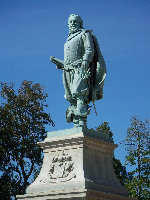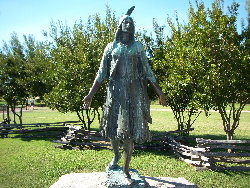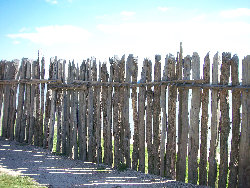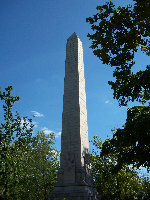In 1606 King James I granted a charter to the Virginia Company of London to establish a settlement in the Chesapeake region of North America. The King's goal was to establish a northwest passage to the Orient, convert the native Indians to Christianity & find gold. In December 1606, 150 brave men & boys boarded three ships, the Susan Constant, the Godspeed & the Discovery set sail from England. In April 1607, 105 remaining souls arrived in Virginia establishing the first permanent English settlement in North America. The tiny colony met with immediate hardships. Brackish water, lack of food swampy terrain & disease made life almost unbearable. Furthermore, the "gentlemen gentry" that comprised the bulk of the party were ill-suited for taming a wild frontier & the area chosen turned out to be the hunting grounds of the local Algonquian Indians. The area was selected because it provided a port & protection from passing Spanish ships. The attacking Algonquians necessitated the building of a fort as top priority & in just over a month the settlers completed a fort, a church a few houses & surrounding palisades. Disease & famine continued to take their toll. It was only because the Algonquians would occasionally halt their harassing raids long enough to trade food for beads & copper & iron implements. It was Captain John Smith whose leadership & trading skills allowed the colonists to survive. Captain Smith became the group's fourth leader in September 1608 & immediately imposed a no work no food policy. Smith's contributions were probably more important in his writings & maps that aided in further colonization. He encouraged people to settle the area with what may be the first written expression of the fundamental idea of America. In a letter back to his countryment Smith wrote, "Here every man may be master & owner of his own labor & land...If he have nothing but his hands, he may, by industry, quickly grow rich." In December 1607 Smith, while on a foraging mission, was captured by the Indians & brought to their leader, Powhatan. By Smith's account, he was brought before Powhatan & his head was laid upon a stone. They were preparing to beat in his brains when Powhatan's daughter, Pocahontas, laid her head upon his to save him from death. Pocahontas would be baptized around 1613 becoming the first Christian convert in America. On April 5, 1614 she married tobacco farmer John Rolfe. They traveld together to England in 1616 where she was greeted as a celebrity & entertained by royalty. She died on the return trip march 1617. An injury would bring about John Smith's return to England in 1609. Upon his departure, the anti-colonist faction of the Algonquian tribe would lay siege to the colonists, cutting off their food supply & ushering in the "starving time" in the winter of 1609-1610. This period saw episodes of madness & cannibalism. By the spring only 60 remained & they were ready to leave. Just in time, another charter arrived with fresh bodies & supplies just in time to re-establish the settlement. The story of Jamestown is one of perseverance & survival. It demonstrates that through hard work, determination & divine will, second chances are possible.
Jamestown, VA





Pocahontas
Palisades
Jamestown Monument
Tower face of original church. Only remaining standing 17th century structure.
John Smith

Construction Replica
Click image to enlarge.





